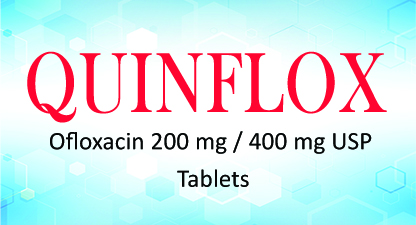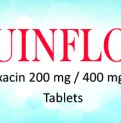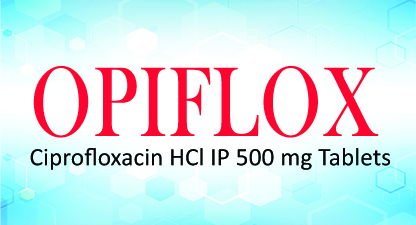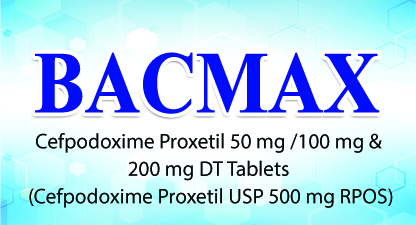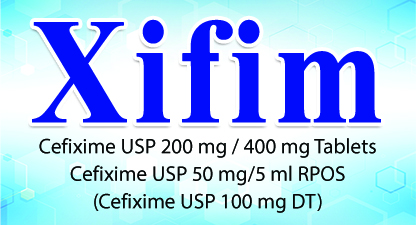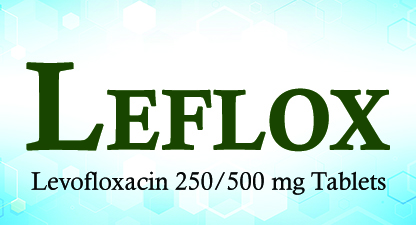QUINFLOX
Ofloxacin is a synthetic chemotherapeutic antibiotic of the fluoroquinolone drug class considered to be a second-generation fluoroquinolone.
Ofloxacin is a broad-spectrum antibiotic that is active against both Gram-positive and Gram-negative bacteria.
- Categories : Antibiotics
- Share Now :
QUINFLOX
Generic Name: Ofloxacin
Therapeutic Category: Antibiotics
Pharmacological Class: Fluoroquinolone
Composition: Quinflox-200
Each film coated tablet contains Ofloxacin USP 200 mg
Quinflox-400
Each film coated tablet contains Ofloxacin USP 400 mg
Pregnancy Category: C
Presentation: Available in the pack size as 10 tablets X 10 blisters
Mechanism of Action
Its mode of action depends on blocking of bacterial DNA replication by binding itself to an enzyme called DNA gyrase, which allows the untwisting required to replicate one DNA double helix into two. Ofloxacin acts on DNA gyrase and toposiomerase IV, enzymes which, like human topoisomerase, prevents the excessive supercoiling of DNA during replication or transcription. By inhibiting their function, the drug thereby inhibits normal cell division.
Notably the drug has 100 times higher affinity for bacterial DNA gyrase than for mammalian.
Indications
- Acute bacterial exacerbations of chronic bronchitis
- Community-acquired pneumonia
- Uncomplicated skin and skin structure infections
- Non-gonococcal urethritis* and cervicitis*
- Mixed Infections of the urethra and cervix
- Acute pelvic inflammatory disease
- Uncomplicated cystitis*
- Complicated urinary tract infections
- Prostatitis*
- Acute, uncomplicated urethral and cervical gonorrhea*.
Dosage
Route of administration: Oral
Bronchitis Exacerbation, Community Acquired Pneumonia, bSkin & Skin Structure Infections: 400 mg twice a day for 10 days.
(Limitations-of-use: Reserve fluoroquinolones for patients who do not have other available treatment options for acute bacterial exacerbation of chronic bronchitis.)
Acute, Uncomplicated Urethral and Cervical Gonorrhea: 400 mg as single dose
Non-gonococcal Cervicitis/Urethritis or Mixed Infection of Cervix/Urethra: 300 mg twice a day 7 days.
Acute Pelvic Inflammatory Disease: 400mg twice a day for 10-14 days.
Uncomplicated Cystitis:
- Due to E. coli or K. pneumoniae: 200 mg twice a day for 3 days.
- Due to other approved pathogens: 200 mg twice a day for 7 days.
(Limitations-of-use: Reserve fluoroquinolones for patients who do not have other available treatment options for uncomplicated urinary tract infections.)
Complicated UTIs: 200 mg twice a day for 10 days.
Prostatitis: 300 mg twice a day for 6 weeks (due to E. coli).
Pharmacokinetics
Absorption: Bioavailability is 98% following oral administration
Protein binding: Approximately 32%
Metabolism: Hepatic
Route of elimination: Renal
Half-life: 9 hours
Adverse Effects
- The most common side effects of ofloxacin include: nausea, vomiting, diarrhea, insomnia, headache, dizziness, itching, and vaginitis* in women.
- Allergic reactions have been described, such as hives* and anaphylaxis* (shock).
- Other side effects include symptoms of nervous system stimulation: Hallucination, anxiety and euphoria*.
Contraindications
QUINFLOX is contraindicated in the following situations:
- Hypersensitivity to ofloxacin or to any of the components of the formulation.
- In patients with a history of epilepsy or an existing central nervous system disorder with a lowered seizure threshold.
- In patients with a history of tendon disorders related to fluoroquinolone administration
- In children or growing adolescents.
Precautions
Risk of following is increased with administration of QUINFLOX
- Tendinitis* and Tendon Rupture
- Peripheral Neuropathy
- Central Nervous System Effects
- Exacerbation of Myasthenia Gravis*
Drug Interactions
- Antacids, Sucralfate, Metal Cations: Can reduce the absorption of QUINFLOX.
- Theophylline: Quinflox reduces the elimination of theophylline.
- Warfarin: Increases bleeding.
*Terminologies:
*Terminologies:
Urethritis: Inflammation of the urethra
Cervicitis: An inflammation and irritation of the cervix.
Cystitis: An inflammation of the bladder.
Prostatitis: The inflammation (swelling) of the prostate gland.
Gonorrhea: A sexually transmitted disease (STD) caused by infection with the bacterium Neisseria gonorrhoeae.
Vaginitis: An inflammation of the vagina that can result in discharge, itching and pain.
Hives: Also known as Urticaria, it is an outbreak of swollen, pale red bumps or plaques (wheals) on the skin that appear suddenly either as a result of the body's reaction to certain allergens, or for unknown reasons.
Anaphylaxis: A serious, life-threatening allergic reaction.
Euphoria: An affective state in which a person experiences pleasure or excitement and intense feelings of well-being and happiness.
Tendinitis: The inflammation of a tendon, most commonly from overuse but also from infection or rheumatic disease.
Indications
- Acute bacterial exacerbations of chronic bronchitis
- Community-acquired pneumonia
- Uncomplicated skin and skin structure infections
- Non-gonococcal urethritis* and cervicitis*
- Mixed Infections of the urethra and cervix
- Acute pelvic inflammatory disease
- Uncomplicated cystitis*
- Complicated urinary tract infections
- Prostatitis*
- Acute, uncomplicated urethral and cervical gonorrhea*.
Contraindications
QUINFLOX is contraindicated in the following situations:
- Hypersensitivity to ofloxacin or to any of the components of the formulation.
- In patients with a history of epilepsy or an existing central nervous system disorder with a lowered seizure threshold.
- In patients with a history of tendon disorders related to fluoroquinolone administration
- In children or growing adolescents.
Dosage
Route of administration: Oral
Bronchitis Exacerbation, Community Acquired Pneumonia, bSkin & Skin Structure Infections: 400 mg twice a day for 10 days.
(Limitations-of-use: Reserve fluoroquinolones for patients who do not have other available treatment options for acute bacterial exacerbation of chronic bronchitis.)
Acute, Uncomplicated Urethral and Cervical Gonorrhea: 400 mg as single dose
Non-gonococcal Cervicitis/Urethritis or Mixed Infection of Cervix/Urethra: 300 mg twice a day 7 days.
Acute Pelvic Inflammatory Disease: 400mg twice a day for 10-14 days.
Uncomplicated Cystitis:
- Due to E. coli or K. pneumoniae: 200 mg twice a day for 3 days.
- Due to other approved pathogens: 200 mg twice a day for 7 days.
(Limitations-of-use: Reserve fluoroquinolones for patients who do not have other available treatment options for uncomplicated urinary tract infections.)
Complicated UTIs: 200 mg twice a day for 10 days.
Prostatitis: 300 mg twice a day for 6 weeks (due to E. coli).

